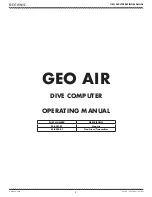
12
ENGLISH
USAGE DURING DIVE
This diving drysuit is intended for use by a certified diver who has successfully
completed a course in the use of drysuits or by a diver in training under the supervision
of a qualified instructor.
Before the dive, vent excess air from the drysuit by pressing the dump valve and crouching down
to your knees. Jumping in the water with excess air in the suit may be hazardous and should be
avoided. Enter the water with your BCD partially inflated.
During the dive, keep the amount of air in the drysuit to the minimum to feel warm and comfortable.
Do not use the drysuit as the main buoyancy device.
CHANGE OF BUOYANCY AND LOSS OF THERMAL INSULATION AT DEPTH
All neoprene products used in scuba diving are made of closed cell foam containing small bubble
of nitrogen to provide thermal insulation. When the pressure increases at depth, these bubbles
diminish in size and the material becomes thinner. This results in a loss of buoyancy and insulation
at depth.
Trilaminate material is a membrane without a closed cellular structure. The material provides minimal
thermal insulation and does not change buoyancy at depth.
Air trapped within the suit by the thermal undergarments provides both thermal insulation and
buoyancy. Variation of depth will result in a change of buoyancy and thermal insulation, therefore air
must be added or vented accordingly.
7. MAINTENANCE
POST-DIVE CHECK
After each dive, complete the pre-dive checks and thoroughly inspect the suit for any new possible
damage that may have appeared during the dive. If any repair has to be made, contact the
manufacturer, or take the suit to an authorized SF Tech dealer.
CLEANING
After each dive, thoroughly rinse the outside of the suit, the seals and the valves with clean fresh
water. Thoroughly rinse both side of the zipper with clean fresh water and brush off any object
attached. If the suit got wet inside, rinse it with clean fresh water and let the drysuit dry inside out.
STORAGE AND TRANSPORT
Proper storage will extend the life of your drysuit. Store the suit in a cool dry place and avoid
direct sunlight, chemicals, open fire, heating devices or electrical equipment producing ozone. It is
important to not store the drysuit folded or rolled as it may cause a deformation and damage the
integrity of the suit. Store the drysuit on a wide hanger with the zipper open. The drysuit can also be
hung upside-down by the feet, zipper open. Before storing the suit for any length of time, dust the
latex seals with unperfumed talcum powder as a preservative
Transport the drysuit properly fold in its bag, zipper
COMPLETELY OPEN
, and do not place any
heavy object on top of it. Do not store the suits in its bag for a long period of time.
Содержание Neoprene Classic
Страница 1: ...SF TECH DRYSUIT User manual Mode d emploi Benutzerhandbuch ...
Страница 39: ...39 DEUTSCH ...
Страница 40: ...SF Tech Sàrl Rte du Verney 18 1070 Puidoux Switzerland WWW SFTECH CH ...













































